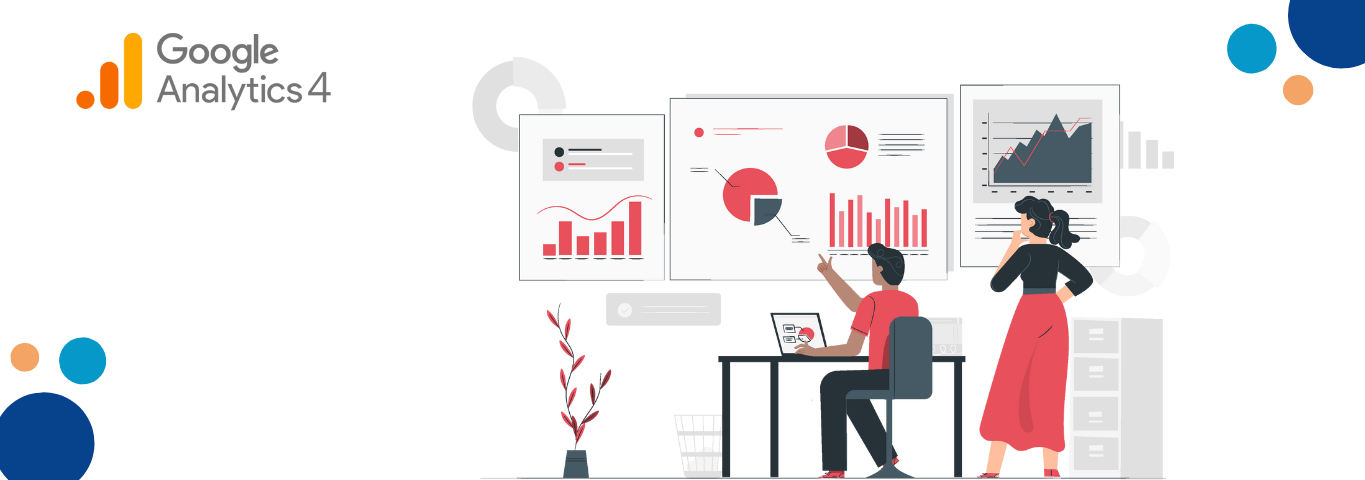Introduction
A brand-new asset created for measuring the future is Google Analytics 4.
- Gathers information from apps and websites to understand the client experience better.
- Uses events rather than session-based data.
- Includes privacy protections, including cookie-free measurement, behavioral modeling, and conversion optimization.
- Without using complicated models, predictive capabilities provide guidance.
- Direct linkages with media platforms encourage behavior.
- Google Analytics 4 is a new property designed for the future of measurement.
From July 1, 2023, standard UA properties will no longer process data. You can see your UA reports after July 1, 2023. However, new data will only stream into GA4 properties.
What is Google Analytics 4?
With Google Analytics 4, marketers can follow a customers journey across all platforms and gain a more in-depth understanding of how they engage with your website and app by utilizing AI and machine learning. The focus of GA4 is also on protecting client privacy. This contradicts several most recent privacy legislation, like the GDPR and CCPA. GA4 is a cutting-edge technology that offers unmatched perceptivity thanks to privacy-first tracking, cross-channel data measurement, and AI-driven predictive analytics.
What are the features of Google Analytics 4?
Google Analytics 4 presents significant advancements compared to its predecessor, Universal Analytics. It was advanced around machine learning, user privacy, audience strategy, and changes coming to the digital industry (deprecation of 3rd party cookies and browser updates around privacy).
GA4 also has an array of engagement metrics, such as:
- engaged sessions
- engagement rate
- engagement time
Below, we will represent you with some of the highlights GA4 offers. However, keep in mind that the list is non-exhaustive and that the GA4 roadmap is coming up with more features!
- Cross-platform The primary importance of GA4 is combining web and mobile data in a single analytics property with the help of event-driven data models and data streams. This is powerful as it enables more robust cross-device and cross-platform monitoring, and that is why it is a better understanding of a user journey and acquisition across all devices.
- Codeless event tracking Google Analytics 4 allows you to track events automatically without setting up event tracking in GTM. These predefined user activities include scroll, page views, outbound clicks, site search, video interactions, and file downloads. To enable these, activate "Enhanced measurement" in the GA4 interface.
- AI-Powered Insights and Predictions GA4 can help business owners to plan their marketing campaigns more effectively. And it comes with new AI-powered insights that can highlight trends similar to growing user interest in a particular product. This machine learning technology can predict outcomes like churn rates, potential conversions, and sales. Marketers can use these insights to promote particular products and target relevant audiences.
- Live to debug with DebugView GA4 allows you to debug your site directly from the GA interface using "DebugView" (You will find DebugView under the Configure tab in the GA4 property). It will show you what hits are being received by your property in real time. To enable this, you can launch the preview mode from GTM if you have it executed on your site, or you can set "debug mode" to true for your tags and GA4 configuration.
- BigQuery exports Earlier only available to GA360 users, GA4 allows you to freely export all your data directly to BigQuery for advanced analysis once you have set up your product linking. You will also be suitable to perform advanced analysis on your data, store your data in BigQuery (Google Cloud), join and enrich with other marketing data, visualize the data in tools like Tableau or PowerBI, and use this data as input for machine learning models.
- Display and Video 360 product linking
Newly released and for the first time in Google Analytics, an Display and Video 360 integration is now available in GA4. This is a crucial integration for users of both platforms, as they have the following advantages:
- Analytics audiences will be exportable to DV360.
- Conversions recorded in analytics will be exportable to display and video 360
- DV360 advertisers will appear as a traffic source in your Analytics Cross-channel reports
- DV360 campaign and cost data will be automatically imported into Analytics.
- Exploration Reports Earlier known as Analysis Hub, Exploration Reports presents a paradigm shift concerning how reports are used in GA. Instead of having too many predefined reports, which can feel inflexible at times, as seen in UA, GA4 provides you with smaller but simpler overview reports, as well as some AI-driven perceptivity, while giving you the capability to make more advanced custom reports that suits your business requirements, thanks to Exploration Reports. You will benefit from predefined analysis ways for your reports, including Funnel Exploration, Segment Overlap, Path exploration, and User explorer.
- Spam Prevention If you have been using GA for a while, you have been hit by an unexpected spike of traffic on a couple of occasions or received many visits from a dubious source. The spammy traffic could disrupt your marketing campaign, making it more challenging to gather accurate data. Fortunately, GA4 has found a way to address this problem. Spammers could shoot fake data to GA accounts using the measurement protocol. Now it only hits with a private key that can send data to a GA4 property. Now, you can access this key from GA4 data stream settings, which are not publicly available.
- Granular user data control GA4 provides you to manage your user data which helps advertisers comply with data regulations similar to GDPR. E.g., IP anonymization is now enabled by default, and user data retention is limited to 14 months (you can permanently save your data in BigQuery if you want to keep it longer). You can also cancel an individual user from analytics directly from the user discoverer if you receive a request to do so or use the data omission requests in the admin panel, where you schedule data deletion for specific events or parameters without deleting further data than needed.
How are GA3 and GA4 Different?
As we have seen, Google Analytics 4 has many new and advanced features, including AI-powered reporting. However, event tracking is crucial between GA3 (Universal Analytics) and GA4.
For example, in GA3, events are related to clicks. In GA4, events can be social interactions, page views, or user actions. Also, you can accelerate several parameters for each event to get relevant information, similar to where it was logged.
GA3 and GA4 are also different when it comes to recording the sessions. In GA3, a session is a group of hits a user makes within a period.
Meanwhile, GA4 tracks sessions as a group of events a user executes. These events may include clicking on a button, purchasing, etc.
Conclusion
From July 1, 2023, Google Analytics 4 (GA4) will replace Universal Analytics (UA). This new version has advanced features for advertisers, marketers, and business owners while prioritizing user privacy.
GA4 introduces AI-powered perceptivity and predictions to help enhance your marketing campaigns. It also provides granular control over data gathering and usage, and it prevents spammy traffic, too.






Comments